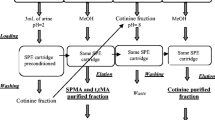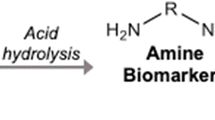Summary
The amount of diazo-positive compounds in urine from workers at a chemical plant producing pharmaceuticals and explosives was determined in samples collected after work and after a holiday. Forty-five persons working with aromatic nitro-amino compounds (ANA) showed a statistically significant (p < 0.01) increase in the exposed samples (1.21 ± 1.40 mmol/mol creatinine) compared to the unexposed samples (0.56 ± 0.31 mmol/mol creatinine). No increase in the level of diazo-positive metabolites was found in the 25 workers not exposed to ANA compounds. In a follow-up study, 32 trinitrotoluene (TNT) workers were divided into three exposure categories and seemed to show a dose-dependent increase in the level of urinary diazopositive metabolites. However, there was a considerable interindividual variation. The method seems suitable for the biological assessment of exposure to ANA compounds — at least on a group level. This may be valuable, especially in situations where significant dermal uptake is expected.
Similar content being viewed by others
References
Ahlborg G Jr, Bergström B, Hogstedt C, Einisto P, Sorsa M (1985) Urinary screening for potentially genotoxic exposures in a chemical industry. Br J Ind Med 42:691–699
Ahlborg G Jr, Einisto P, Sorsa M(1987) Mutagenic activity and metabolites in urine from trinitrotoluene (TNT) exposed workers. Br J Ind Med (in press)
Clark LC, Thompson HL (1949) Determination of creatinine and creatinine in urine. Anal Chem 21:1218
Chin CW, Lee LH, Wang CY, Bryan GT (1978) Mutagenicity of some commercially available nitrocompounds for Salmonella typhimurium. Mutat Res 58:11–22
Hemminki K, Sorsa M, Vainio H (1979) Genetic risks caused by occupational chemicals: use of experimental methods and occupational risk group monitoring in the detection of environmental chemicals causing mutations, cancer and malformations. Scand J Work Environ Health 5:307–327
Ikeda M, Watanabe T, Hara I, Tabuchi T, Nachamora Si, Kosaka H, Minami M, Sakuri Y (1977) A field survey on the health status of workers in dye-producing factories. Int Arch Occup Environ Hlth 39:219–235
Chemical Industry Institute for Toxicology, (1982) 104 week chronic toxicity study in rats: dinitrotoluene — final report. Reno FE, Ulland BM, Alsker RD (eds) Chemical Industry Institute for Toxicology, Research Triangle Park, NC
Watanabe T, Ishihara N, Ikeda M (1976) Toxicity and biological monitoring for 1,3-diamino,2,4,6-trinitrobensen and other nitroaminoderivatives of benzene and chlorobenzene. Int Arch Occup Environ Hlth 37:157–168
Zakhari S, Villaume JE (1978) Occupational health and safety aspects of 2,4,6-trinitrotoluene (TNT). A literature review - problem definition studies on selected toxic chemicals. Philadelphia: Science Information Services Organization. Franklin Inst Res Lab 3:43–52
Author information
Authors and Affiliations
Rights and permissions
About this article
Cite this article
Ahlborg, G., Ulander, A., Bergström, B. et al. Diazo-positive metabolites in urine from workers exposed to aromatic nitro-amino compounds. Int. Arch Occup Environ Heath 60, 51–54 (1988). https://doi.org/10.1007/BF00409379
Received:
Accepted:
Issue Date:
DOI: https://doi.org/10.1007/BF00409379




